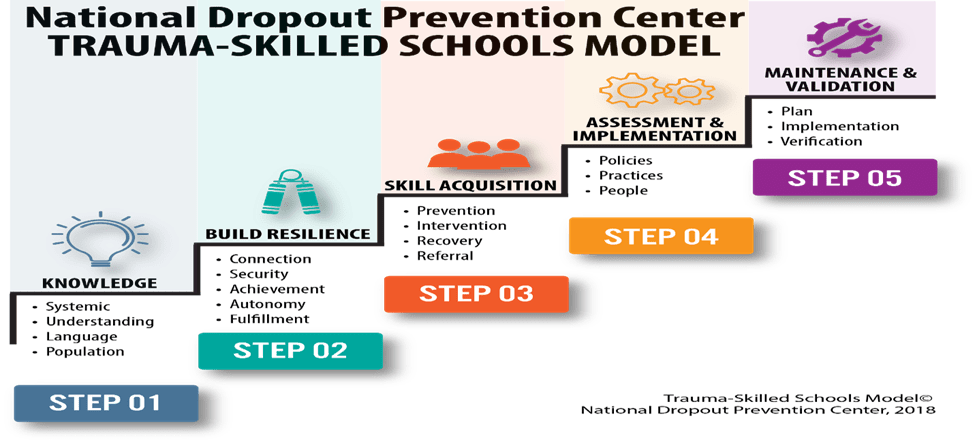Introduction to the Trauma-Skilled Schools Model
Research clearly indicates that students in our schools are dealing with unprecedented levels of stress and increasing exposure to traumas. This stress of life, and prevalence of traumas can negatively impact a student’s cognitive functions and behaviors in school. Educators are calling for additional support in the form of guidance counselors, school psychologists, and behavioral specialists to deal with these growing challenges. Trauma, however, is particularly challenging for teachers/educators to address because students often do not express the distress they are feeling in a way that is easily recognizable, and they may mask their pain with behavior that is aggressive or off-putting. The Trauma-Skilled Schools Model (TSS Model) seeks not to identify trauma-impacted students, but to build within the district/school/teachers/staff the capacity to deepen their understanding of trauma, create strategies, policies and procedures that support students, and establish a culture that eliminates practices that may be detrimental to trauma-impacted students.
The TSS Model should be considered a Tier 1 RTI strategy that positively impacts all students, and when implemented effectively, will help students recognize their strengths and build their self-confidence and self-efficacy needed to be a successful learner.
Rationale for the Trauma-Skilled Schools Model
Description of the Trauma-Skilled Schools Model
The Trauma-Skilled Schools Model involves a five-step process that begins with establishing foundational trauma knowledge among all school site personnel. The model then utilizes knowledge to establish common practices among all staff members that create and reinforce the resiliency skills that are essential to school success and that are particularly important for trauma-impacted students. All staff members are guided to understand and master relational and instructional skills that minimize the interference of trauma with appropriate behavior and learning. School leaders and the designated Lead Team members are taught and supported in acquisition and practice of steps to institutionalize and maintain the Trauma-Skilled Schools Model over time.

Implementation of the Trauma-Skilled Schools Model
Implementation of the Trauma-Skilled Schools Model is always designed in collaboration with local leaders and considers local and cultural contexts, existing understandings, prior training, and availability of staff for training. It is recommended that the Trauma-Skilled Schools Model be implemented at a participating school site over a two-year period with training and guidance by a three- to five-member team of Trauma-Skilled Faculty members from the National Dropout Prevention Center (NDPC). Implementation is designed in consultation with school site leaders and typically involves the following steps.
Comparison of The Trauma-Skilled Schools Model to Other Trainings and Programs
• The Trauma-Skilled Schools Model does not replace emergency response plans or practices and does not prepare teachers to function as counselors, therapists, or behavioral specialists. It equips all educators to interact with and instruct students in ways that negate the behavioral and instructional influences of stress and trauma.
• Much trauma training attempts to impart mental health information and strategies to educators. Trauma-Skilled Schools training guides all educators (teachers and support personnel) to adopt behaviors, practices, and instructional strategies that significantly increase the likelihood of success and learning of all students, with a focus on the needs of those who are trauma-impacted.
• Most “trauma-informed” or “trauma-sensitive” training leaves next steps to discretion of the individual educator and results in inconsistent and random “acts of trauma accommodation”. Trauma-Skilled Schools training creates agreed-on understandings, common vocabularies, and consistent patterns of educator behaviors toward all students and does not require identification of individual trauma-impacted students.
• The Trauma-Skilled Schools Model is not a program or something else for educators to do. It is a guided model that helps educators modify and standardize existing climate, practices, and instruction to achieve better student outcomes.
For additional information contact Todd Daggett – tdaggett@spnetwork.org
References and Resources
Improving School Outcomes of Trauma-Impacted Students(2018, J. Gailer, S. Addis, L Dunlap, W. Daggett, R. McNulty)
Trauma Skilled Schools Model Presented to SC House Education Committee(2018, S. Addis)